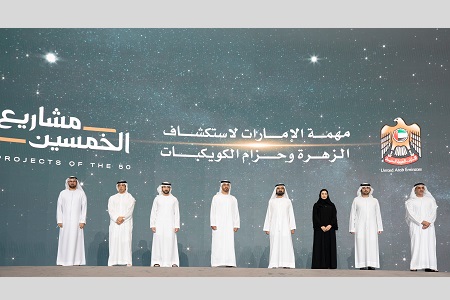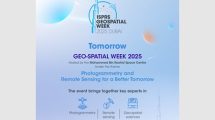 The UAE Space Agency has announced the commencement of a new Emirati interplanetary mission, designed to further accelerate the young nation’s space engineering, scientific research and exploration capabilities, and drive innovation and opportunity in the country’s private sector.
The UAE Space Agency has announced the commencement of a new Emirati interplanetary mission, designed to further accelerate the young nation’s space engineering, scientific research and exploration capabilities, and drive innovation and opportunity in the country’s private sector.
The new mission will involve significant participation from Emirati private sector companies. It is scheduled for launch in 2028, with the primary goal of exploring the asteroid belt between Mars and Jupiter, the source of most meteorites that impact the earth.
Speaking about the new mission, Sheikh Mohammed bin Rashid Al Maktoum, Vice President and Prime Minister of the United Arab Emirates and Ruler of Dubai, said: “We have set our eyes to the stars because our journey to development and progress has no boundaries, no borders and no limitations. Today we are investing in the generations to come. With each new advancement we make in space, we create opportunities for young people here on earth.”
Mohamed Bin Zayed Al Nahyan, Crown Prince of Abu Dhabi and Deputy Supreme Commander of the United Arab Emirates Armed Forces, added: “This new mission tests and extends the capabilities of Emirati youth in achieving Zayed’s ambition to explore space. We are certain that our talented local engineers, academic and research institutions, which have so far made quantum leaps in developing our space sector, are well equipped to take on this daring new challenge.”
The spacecraft will undertake a 3.6bn-kilometre, five-year journey, which will see it perform gravity assist manoeuvres by orbiting first Venus, then Earth in order to build the velocity required to reach the main asteroid belt, located beyond Mars. Its trajectory around Venus will see it reaching solar proximity of 109m kilometres, requiring substantial thermal protection and the furthest distance from the sun of 448m kilometres, requiring high levels of insulation and spacecraft operation with minimal levels of available solar energy.
Through its journey, it will study seven main-belt asteroids. It will be built using the substantial heritage and intellectual property (IP) acquired during the development of the Emirates Mars Mission and its Hope Probe, currently orbiting Mars and gathering unique data on Mars’ atmospheric composition and interactions.
Sarah Al Amiri, Chair of the UAE Space Agency, stated: “Our goal is clear: to accelerate the development of innovation and knowledge-based enterprises in the Emirates. This can’t be done by going steady-state, this requires leaps in imagination, in faith and the pursuit of goals that go beyond prudent or methodical. When we embarked on the Emirates Mars Mission, we took on a six-year task that was in the order of five times more complex than the earth observation satellites we were developing. This mission is in the order of five times more complex than EMM.”
Hamad Obaid Al Mansoori, Chairman, MBRSC, remarked: “We are proud of the announcement of the UAE’s new space mission, which will make us the first Arab country and the fourth country in the world to send a space mission to Venus and an asteroid belt. This mission, with its unprecedented scientific goals, will enhance the UAE’s contribution to the scientific progress of humanity. The announcement also coincides with our upcoming celebration of the golden jubilee of the founding of the UAE, confirming our consistent approach to contribute to humankind under the vision of our wise leadership. The words of His Highness Sheikh Mohammed bin Rashid Al Maktoum, Vice President and Prime Minister of the UAE and Ruler of Dubai, during the announcement reflects the ambition of the UAE and its people, which does not stop at any limit.”
He continued: “The UAE has always aimed at investing and improving the lives of people, and today, through the continued guidance of our leadership, we are able to meet the most difficult challenges as we grow and develop. His Highness Sheikh Mohammed bin Zayed Al Nahyan, Crown Prince of Abu Dhabi and Deputy Supreme Commander of the Armed Forces, has himself expressed that our national cadres and talents along with our academic and research institutions have achieved qualitative achievements in the space sector that are able to take on the task of the new space mission with full efficiency and readiness. In line with the national agenda, we, at the Mohammed Bin Rashid Space Centre, will continue our strategic efforts to build a strong and sustainable space sector, support and protect national interests and vital sectors, contribute to the diversification and growth of the country’s economy, enhance specialised national competencies, develop scientific and technical capabilities, and further strengthen the UAE’s role and position regionally and globally.”
Yousuf Hamad AlShaibani, Director-General, MBRSC, commented: “The announcement to send a space mission to explore the planet Venus and the asteroid belt is a source of pride for every citizen and resident in the UAE, and for every Arab who believes that we represent our civilization, cultural and scientific heritage in the best possible way. The new mission will contribute to the development of advanced technologies and technological innovations previously unknown to mankind in various sectors, disciplines and space sciences. We are aware of our responsibility in this regard to contribute effectively to the achievement of this historical scientific leap of human knowledge.”
He added: ”The UAE’s achievements in the space sector are a result of a clear strategy, that is the embodiment of the vision of His Highness Sheikh Mohammed bin Rashid Al Maktoum, Vice President and Prime Minister of the UAE and Ruler of Dubai, and His Highness Sheikh Mohammed bin Zayed Al Nahyan, Crown Prince of Abu Dhabi and Deputy Supreme Commander of the Armed Forces. The year of the fiftieth has so far witnessed great achievements for the country in the space sector. At the beginning of the year, the Hope Probe reached Mars, and in the middle of it, we announced the second batch of the UAE Astronaut Programme, including the first Arab female astronaut.”
The mission will make its first close planetary approach orbiting Venus in mid-2028, followed by a close orbit of Earth in mid-2029. It will make its first fly-by of a main asteroid belt object in 2030, going on to observe a total of seven main-belt asteroids before its final landing on an asteroid 560m kilometres from Earth in 2033. This will make the Emirates the fourth nation to land a spacecraft on an asteroid.
The mission is to be developed in partnership with the Laboratory for Atmospheric and Space Physics (LASP) at the University of Colorado, Boulder. LASP was the primary knowledge transfer partner for EMM, bringing over seventy years’ experience in spacecraft and instrumentation design and development and helping advise, train and develop the team of Emirati engineers, software developers and scientists who worked on EMM, many of whom will go on to work on this new mission.
Five initiatives are being launched around the new mission by the UAE Space Agency to accelerate the development of the UAE’s space sector: a fully-funded programme to establish Emirati space sector businesses; priority access to contracts and procurement for the mission by Emirati companies; a vocational training programme to train young Emiratis on component assembly and space subsystems engineering; a programme to bring local and international universities and research centres together to work on the mission, including LASP and Emirates University.














Add Comment